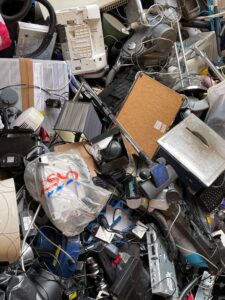Waste Management: Where on Earth do you start? Why should I care?
In this guest blog Jacky Sherman The Consultants’ Consultant and chair of The Green Business Network shares her tips on how to reduce waste within your business.
The first thing that strikes you on reading the Government documents on waste management is the enormity of the subject and the amount of regulations involved. https://www.gov.uk/topic/environmental-management/waste
On the positive side it also provides a huge amount of information too and quite probably a lot of it may not apply to you.
Every business has a unique footprint of waste and is at the differing level of how effectively they are managing it. Your task as the leader in your company is to work out which bits are relevant. How do you get started?
Here are my 7 first steps in the process of managing waste out of your business.
- Commit to eliminating waste instead of just dumping it. The diagram below is the Green Business Network’s take on the waste hierarchy, a model that is widely used to categorise the different ways you can approach waste. Traditionally this is portrayed the other way up where the majority of the effort spent on waste was seen as either disposal, such as landfill, or recovery such as incineration and using the heat to produce usable energy.
The new mindset is to turn that hierarchy on its head as in this diagram and design in prevention and reduction of waste the priority in all business and operational processes, .The smaller diagram gives more detail on how to achieve a circular economy ie. where your waste is someone else’s raw materials.
2. Start with the obvious We’re straight back to the Government document and investigating what legislation you must comply with to stay out of trouble. We’ll come back to this at step 7.
For now, let’s turn to your financial information and pay attention to how you might be wasting your hard earned money.
-
- What are you spending on energy to light and heat your premises ?
- How much are you spending on water, sewage and your waste collection?
- What are the costs of your production processes?
- How much do you spend on maintenance or down time because of breakdowns or using old antiquated machinery?
- Lastly transport costs to get your team out to service customers, attend meetings etc?
- How thoroughly and how often do you review these costs to identify waste?
Chances are there is scope for some quick wins which often release money to be spent on the trickier aspects of reducing waste production.
3. Look in the bin. I’ve separated this out from the obvious as it is one of those obvious steps that few people actually take. If your business is small then you may feel you know what you’re throwing away. A small anecdote suggests that even in companies with a green strategy bad habits creep back in. A company I visited recently had a double bin by the coffee machine, with one side for recyclables and one for “other“ waste. On removing the lid I discovered that both sides went into one general waste bin liner. They had lost the bin separators and some enterprising soul had fixed it with a communal bin liner.
business is small then you may feel you know what you’re throwing away. A small anecdote suggests that even in companies with a green strategy bad habits creep back in. A company I visited recently had a double bin by the coffee machine, with one side for recyclables and one for “other“ waste. On removing the lid I discovered that both sides went into one general waste bin liner. They had lost the bin separators and some enterprising soul had fixed it with a communal bin liner.
For bigger companies, when did you last walk around the back to look in your bins? The day before they are due for emptying is a good time. Do you know what you actually throw away? What can you remedy immediately and what will need more thought?
4. Engage your stakeholders. This is not something you can do alone so get everyone engaged in what you’re trying to achieve. As the anecdote above shows everyone from the most junior members of staff in your business has a role to play. What about other stakeholders? Your energy suppliers may be able to offer smarter meters, your customers may have vital information around your packaging. Your investors may need to approve new machinery.
5. Pace yourself. You can’t do it all at once. The word sustainability means the ability to be maintained at a certain rate or level and that applies equally to your business and to the planet. Avoid what one very astute boss I had called whirlwind management. When in a rush of enthusiasm you throw everything up in the air and then once you’ve moved on it all comes back down in a bigger mess than how you started. Take things at a pace people can cope with and make each area stick before moving on.
6. Record, Report, Reward, In the beginning record how things are and then mark off improvements as they happen. Some of this may be financial savings, less bin collections, improved productivity, reduced carbon footprint, or recycling plastics. To embed this into your culture, achieve sustainability and get engagement for the trickier steps to come make sure every improvement is communicated positively and reward everyone who was involved in making it happen.
7. Use the experts. When looking at our own business we can, on more occasions than we ‘d like to admit, be short-sighted, or even blind to the possibilities for improvements and innovation. If you’ve heavily invested time, energy and money in your current practice it can be hard to pull back and be creative and make radical changes.
It’s good to remember in this area that you don’t know what you don’t know. Your expertise comes from your professional discipline and if that’s not managing the environment then you can make costly mistakes in investing in the wrong areas or get into real trouble in misinterpreting the plethora of regulations ( back to step 1) . On top of this you’re unlikely to have the time or relevant background to explore more left field solutions to the trickier problems (See below for my favourite example).
Leather from Pineapples.
 Piñatex was created by Carmen Hijosa, who worked in the Philippines leather goods industry in the 1990s. As a consultant in the leather goods industry she initiated this change because she was actively looking for new alternatives to leather over concerns about the pollution in the tanning industry. Managing the pollution from the tanning process seemed unsolvable and Carmen, as an environmentalist, was aware of the emerging imperative to seek plant alternatives. So she started looking for alternatives to leather, an approach which would have been a big ask from the local leather producers. She found that a traditional Filipino garment called Barong Talong was made from the strong, durable fibres of pineapple leaves.
Piñatex was created by Carmen Hijosa, who worked in the Philippines leather goods industry in the 1990s. As a consultant in the leather goods industry she initiated this change because she was actively looking for new alternatives to leather over concerns about the pollution in the tanning industry. Managing the pollution from the tanning process seemed unsolvable and Carmen, as an environmentalist, was aware of the emerging imperative to seek plant alternatives. So she started looking for alternatives to leather, an approach which would have been a big ask from the local leather producers. She found that a traditional Filipino garment called Barong Talong was made from the strong, durable fibres of pineapple leaves.
I doubt if the pineapple canneries working on their own would think of “faux leather” as a route to get rid of the parts of the pineapple they didn’t use. On a plus I gather that the waste from the faux leather industry goes back onto the land as fertiliser. Nice example of the circular economy.
Photo by Neora Aylon on Unsplash
So build your own Green network, get to know and build your relationships with a wide range of experts in the various disciplines engaged in this agenda, as well as your fellow business leaders facing similar issues, plus increasing the opportunities to meet and collaborate with those with left field ideas that you would never have thought of by yourself.
The Green Business network is one such organisation as a not-for-profit company it brings together business leaders who are on their journey with those who supply the environmental alternatives and solutions. By sharing our knowledge, experience and business contacts we are committed to enabling all businesses to tackle their waste and make their business sustainable as well as contributing to healing the planet.
Jacky Sherman
The Consultants’ Consultant
 Enabling solo business owners to build a better business than they could on their own. Following a successful career in Health care 18 years ago Jacky set up her own coaching company. Realising she knew very little about building a business and with no local network she turned to Asentiv to learn the skills necessary. Then eight years later she bought into the company in Northamptonshire and Milton Keynes where she now mentors and coaches solo business owners who, like her, left employment to set up on their own. Her ambition is to watch them succeed in building the business of their dreams, for more information visit www.jackysherman.com
Enabling solo business owners to build a better business than they could on their own. Following a successful career in Health care 18 years ago Jacky set up her own coaching company. Realising she knew very little about building a business and with no local network she turned to Asentiv to learn the skills necessary. Then eight years later she bought into the company in Northamptonshire and Milton Keynes where she now mentors and coaches solo business owners who, like her, left employment to set up on their own. Her ambition is to watch them succeed in building the business of their dreams, for more information visit www.jackysherman.com
She splits her spare time between her family and enabling local businesses to respond to the environmental crisis as the Chair of the Green Business Network.






